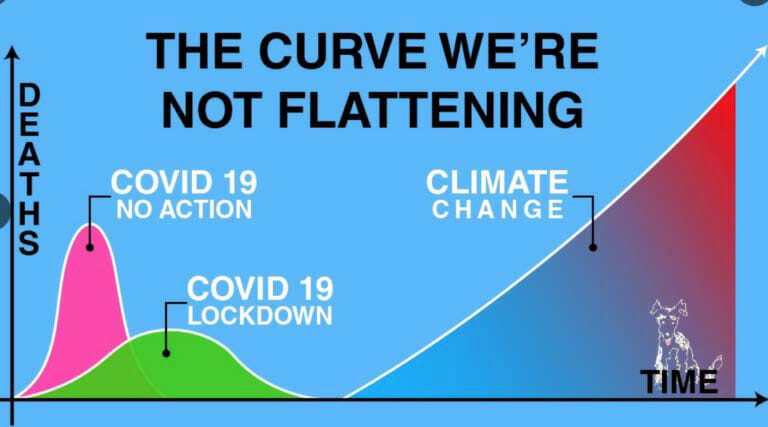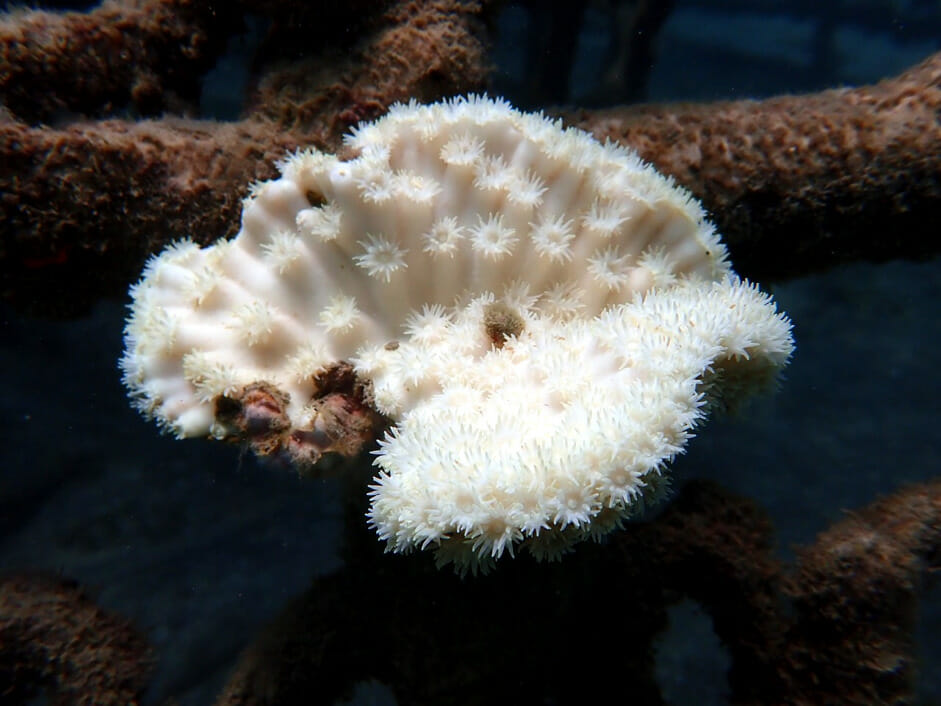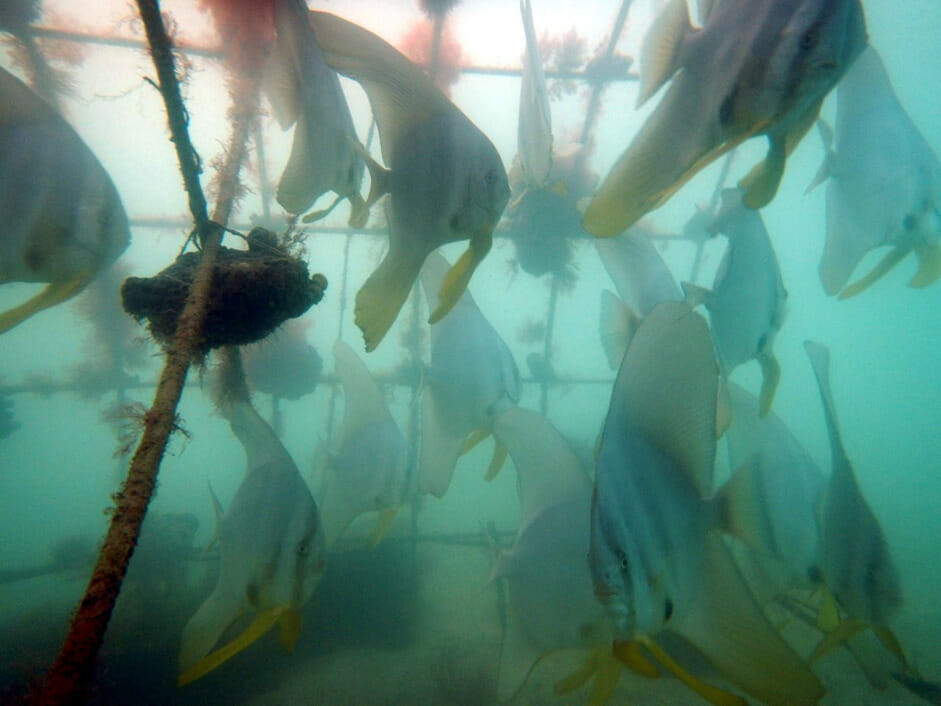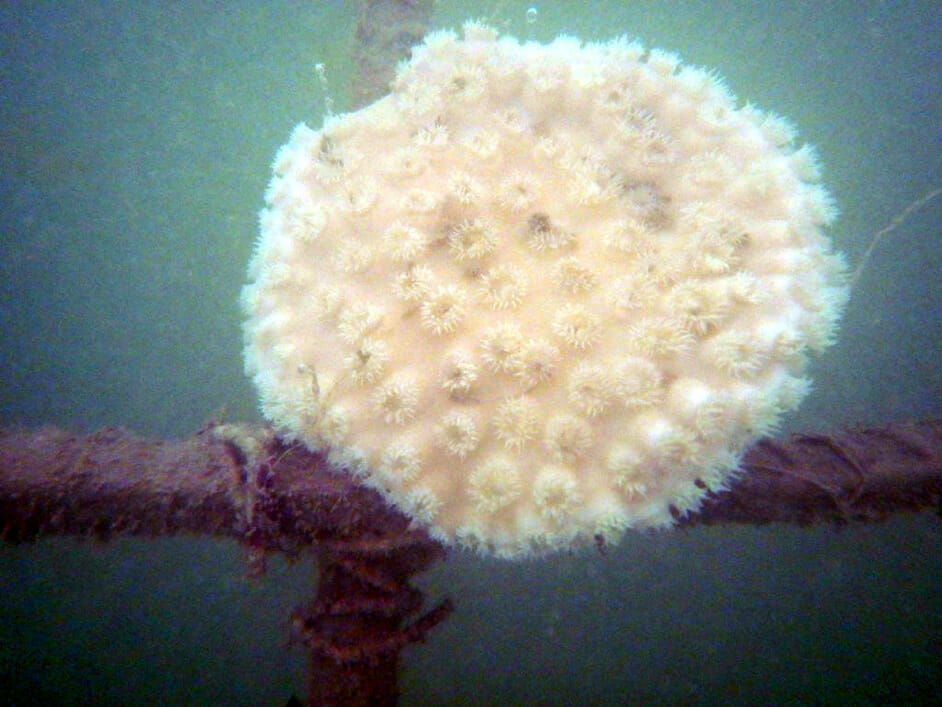Flattening the CO2 Curve to Save Corals
Thomas J. F. Goreau, PhD
President, Global Coral Reef Alliance
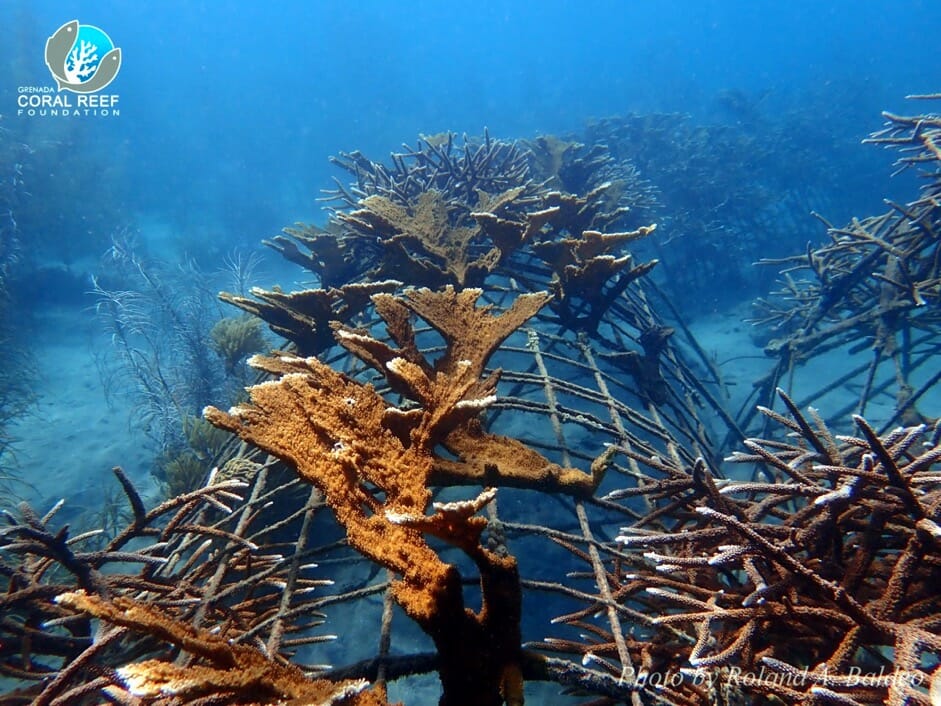
Biorock Coral Ark regenerating Caribbean coral reefs December 11th, 2020, Roland Baldeo, Grenada Coral Reef Foundation
Large scale death of corals from high temperature, pollution, and disease accelerated in 2020 as a result of fossil fuel-subsidizing policies of the US, Russian, Saudi Arabian, Brazilian, and Australian governments. Just as the Covid Curve must be flattened before health services collapse, we must flatten the CO2 curve before global environmental health collapses and there are no coral reefs left. This does NOT mean net-zero CO2, it means reducing CO2 to pre-industrial levels as fast as possible! Reversal of coral reef killing energy policies by the US Government that will begin on January 20th, 2021 needs to be accompanied by large-scale locally-managed coral regeneration initiatives in developing countries.
Coral reefs passed the global coral bleaching tipping point in the 1980s. In 1987 GCRA’s Tom Goreau published the first paper calling for a carbon tax specifically earmarked to pay for vegetation and soil carbon storage to reduce CO2 to safe Pre-Industrial levels. Ignored for decades, this view has recently become the scientific consensus.
Geotherapy, reversing global warming and stabilizing climate through regenerative development, can be achieved by increasing biomass, biodiversity, and carbon storage of soils by increasing soil fertility with basalt rock powder and biochar. In the oceans, GCRA’s Biorock methods can be used for large scale regeneration of coral and oyster reefs, see: Innovative Methods of Marine Ecosystem Restoration, regenerating severely eroded beaches naturally at record rates, and the marine soils of coastal wetlands: mangroves, sea grasses, and saltmarshes, which are the most cost-effective global carbon sink.
2020 Global Coral Bleaching
Due to Covid, coral reef monitoring around the world has essentially stopped as travel, diving, and tourism collapsed. Dive shops long ago stopped reporting coral bleaching because it was “bad for business”. Fortunately, we can accurately predict coral bleaching using GCRA’s 30 year old Goreau-Hayes Coral Bleaching HotSpot method, which showed the earth passed the coral bleaching tipping point in the 1980s. The US and Australian Governments, and the researchers they paid, spent 35 years after the coral bleaching tipping point was passed denying that global warming was killing corals, allowing reefs to die by preventing action on CO2 when it might have made a real difference.
In early 2020 GCRA first predicted severe bleaching in the Great Barrier Reef, followed by Indonesia, India, Thailand, Viet Nam, China, Taiwan, Palau, Federated States of Micronesia, Aruba, Bonaire, Curaçao, and Venezuela. Typically, the world press reported bleaching only in Australia and ignored the developing countries, environmental racism that imperils coral reefs and the people and entire islands that depend on them. 2020 will turn out to be among the worst coral bleaching years to date, even though it was a La Niña year when global ocean surface temperatures were BELOW normal! The next El Niño year, likely in 2021, will exacerbate global bleaching. At the very end of 2020, a large HotSpot is developing over North East Australia and Papua New Guinea, and the northern GBR is already at bleaching temperatures. While it is too soon to predict, the southern summer is only starting, and unless it soon turns unusually cool, another major bleaching event there is likely in early 2021 when southern hemisphere temperatures reach their peak.
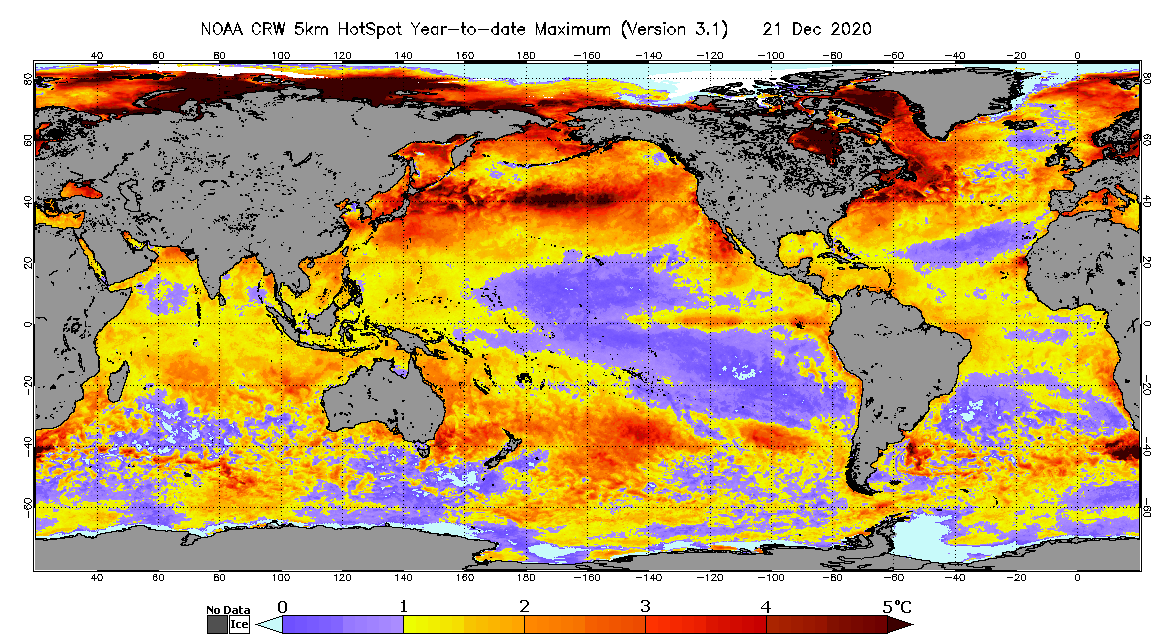
2020 maximum HotSpot. Coral reefs in orange and red areas would have bleached strongly, bleaching would have been mild in yellow areas. Notice the record heat in the Arctic, which caused catastrophic loss of sea ice that will accelerate global warming.
Biorock Coral Arks to save coral reef ecosystems from extinction
In 2020 Biorock Coral Arks once again saved corals from dying in severe bleaching events in Bali, in Lombok, and in India. Biorock is the only method that allows corals to survive severe bleaching, as well as most other forms of extreme environmental stress, greatly increasing settlement, growth, and survival because it acts directly to increase biochemical energy. No other method does. The endangered Caribbean staghorn coral spawned on Curaçao Biorock in 2020, although widespread coral reproductive failure has been noted across much of the region because thermally stressed corals lack the energy to reproduce. GCRA is already growing most of the world’s coral species on Biorock Coral Arks, but the global warming crisis makes it critical to establish Biorock Coral Arks in every coral reef region and country to save their biodiversity.
There is much talk now about the “Blue Economy”, making money from the sea, but there will be NO sustainable Blue Economy unless we regenerate coastal ecosystem resources with Biorock Technology, and apply Biorock methods for much more productive and sustainable mariculture.
This has not happened because there is still no funding for methods that really work although we have already lost most of the corals in the world to global warming. Meanwhile, funding agencies waste millions on coral breaking and gluing projects that fail whenever the water gets too hot or polluted again. Coral fragmentation is not new and attachment of broken coral has been known for more than 200 years, but now it inevitably fails because corals die from poor water quality and high temperature. Biorock corals survive these conditions by being healthier.
Biorock projects are emergency efforts to rescue ecosystems from total collapse and regenerate fisheries habitat and beaches. Like emergency health personnel risking their lives to prevent health system collapse, Biorock coral reef regenerators are emergency ecosystem saviors. Health workers get an (insufficient) salary for their life-saving work, while reef regenerators are volunteers who risk their lives for no salary at all! Environmental care is an essential professional service just like health care, and developing countries urgently need funding to educate and train their own people to manage their own resources, and not remain dependent on short-term visitors from rich countries.
The US and Australia control international funding for coral reef research, monitoring, and protection. Their funding goes to setting up Marine “Protected” Areas that fail because they cannot be protected from global warming and pollution, and on jet-setting tourist scientists from rich countries, showing people how to break and cement corals, with none to support locally developed initiatives by community-managed groups in developing countries. It seems they just won’t fund Biorock because it is a developing country technology developed and applied by little brown and black island people without rich country expertise or funding to claim the credit (although they will often copy us and then claim to have invented it, but usually fail through lack of training).
Indonesia
Indonesia has the largest area of coral reefs in the world, and by far the highest marine biodiversity in the world so is central for reef preservation. It also has around 80% of the Biorock reefs in the world, on Bali, Lombok, Sulawesi, Flores, Sumbawa, Java, Ambon, Sumatra, and other islands. Much of Indonesia suffered severe bleaching early this year, but it was entirely ignored by the Australia-obsessed international press!
The 1998 Indonesia Economic Crisis caused massive unemployment and catastrophic increases in reef bombing and poisoning, coinciding with extreme coral bleaching mortality, which severely damaged most of Indonesia’s coral reefs. GCRA’s TG documented these losses in Bali and immediately started Biorock regeneration projects in areas that had been devastated. Since Covid, Indonesia has been closed to foreigners, and tourism, which supports 80% of Bali’s economy, has collapsed. This means less pollution from resort sewage and physical damage by tourism operations, but also an increase of unemployed people turning to fishing to survive.
Biorock Indonesia groups, Yayasan Karang Lestari in Bali and the Gili Eco Trust in Lombok once again saved entire Biorock reefs from dying from severe bleaching in 2020 as they had done in 2016, the first time that reefs have been saved twice from dying from high temperature.
The Indonesian Government has created a special Covid economic stimulus plan to help unemployed divers and boat operators in Bali regenerate severely damaged reefs in major tourist areas. Solar-powered Biorock projects in Nusa Dua, Sanur, and Buleleng will cover 100 hectares each and employ hundreds of local divers, boat operators, welders, electricians, etc. These projects are being installed in December 2020 and will be reported on by GCRA partner Biorock Indonesia.
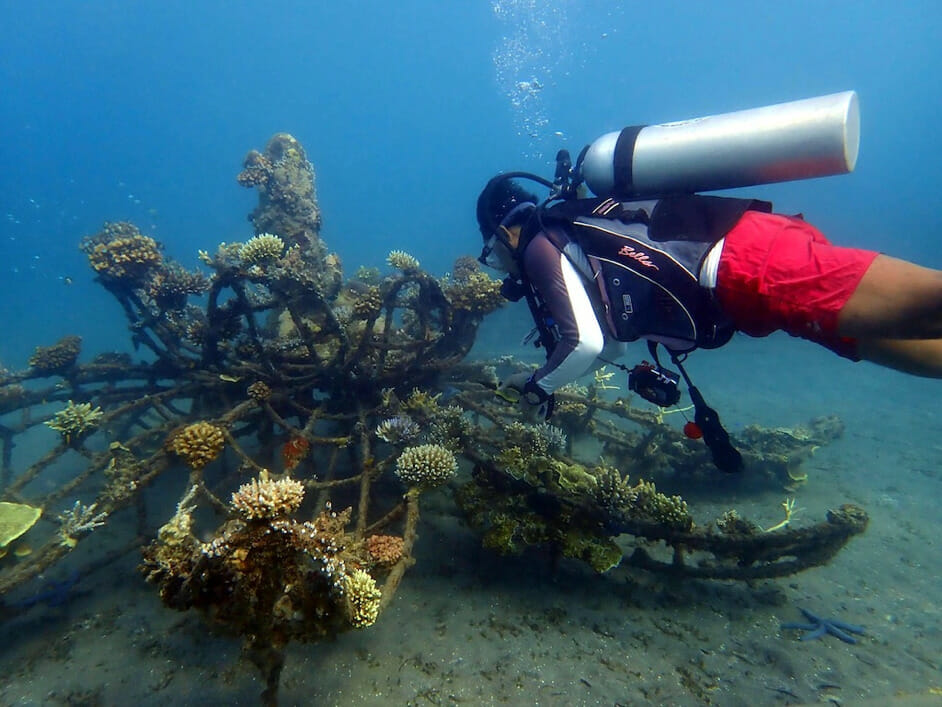 Fully recovered Biorock reef with no coral mortality. Pemuteran, Bali, October 2020. Photograph by Yayasan Karang Lestari.
Fully recovered Biorock reef with no coral mortality. Pemuteran, Bali, October 2020. Photograph by Yayasan Karang Lestari.
India
Solar-powered Biorock coral projects were started in January 2020 by Dr. Chowdula Satyanarayana, Dr. Chandran Retnaraj, and the top coral reef biodiversity team from the Zoological Survey of India. The projects are between Dwarka and Bet Dwarka in Kachchh, Gujarat, the coastal heartland of ancient pre-Vedic Indian civilization, and were supported by the Gujarat Forest Department and the Zoological Survey of India. Schools of batfish moved in immediately after installation. Extreme stress from waves and mud battered the projects soon after installation, followed by a severe bleaching event. The Biorock corals bleached but all survived and recovered and appeared very healthy even while bleached. Dr. Satyanarayana and the ZSI team will report in detail on coral growth, survival, and biodiversity evolution of the Biorock reefs in comparison with many nearby control reefs and conventional coral nurseries. GCRA’s Tom Goreau conducted the first India Biorock Training Workshop just prior to installation of the project, has been a keynote speaker in three Indian webinars on ecosystem services regeneration, and written several book chapters on this. GCRA is working with colleagues across India to develop large-scale projects to regenerate coastal ecosystems and their environmental services.
Grenada
Grenada projects, installed two years ago continued to do well, despite fishermen dropping a net on Biorock reefs to catch a school of jacks, which broke off corals. The Grenada Coral Reef Foundation team reattached the broken pieces, which had first been rescued from a reef destroyed by yacht anchors, and they have continued to grow. The Gouyave projects have had some power problems due to a long cable down a 100-meter cliff, so GCRF plans to convert the projects to power from a floating solar panel raft in 2021. The Carriacou projects continue to work, but are down-current from the town and being overgrown with algae blooms due to high nutrients. GCRF plans to move them in 2021 to another location with better water quality, where they will be powered by solar panels.
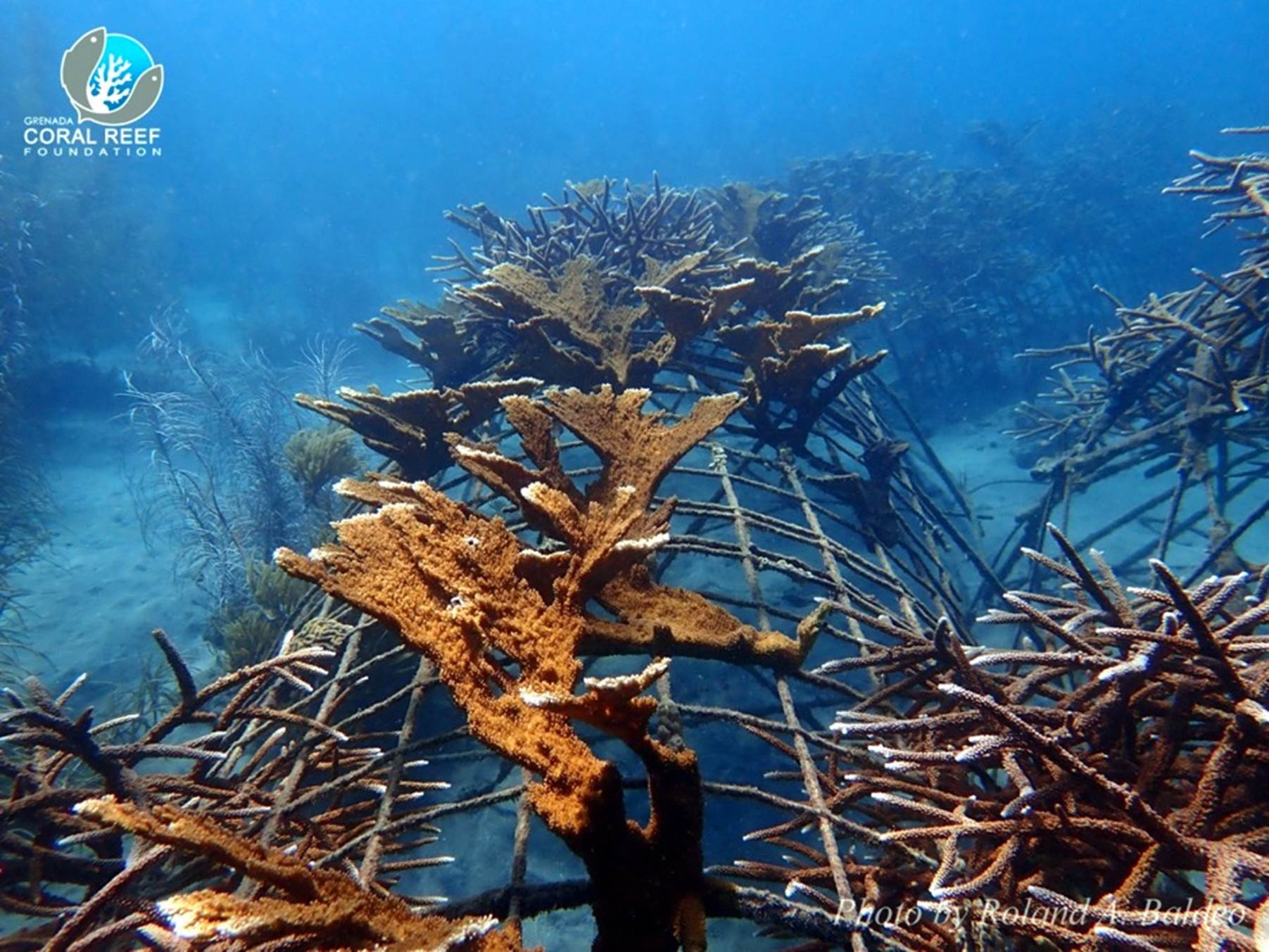
Biorock Coral Ark regenerating Caribbean coral reefs.
Photo Dec 11 2020, by Roland Baldeo, Grenada Coral Reef Foundation
Barbados
Biorock projects in partnership with the Barbados Blue Green Initiative, were approved by the Barbados Government, but Covid slowed approval and delayed required baseline studies. These are now underway, with first project installation expected early in 2021.
Barbuda
Barbuda is a dry island, inhabited by the Eastern Caribbean’s master fishermen, who live from the sea. The Barbuda Council invited GCRA’s Tom Goreau to address them on the potential impacts of the proposed golf course, mega-yacht marina, and resort developments on Barbuda’s unique marine resources. The results of a similar project in the Bahamas by the same developer were presented, along with specific impacts that would happen in Barbuda. Reversing the severe erosion caused by Hurricane Irma (see images below), which threatens the island’s critical lobster, conch, and fish nursery grounds, can be best done by growing Biorock reefs to regrow the beach. Workshops on marine fisheries regeneration were held with the Barbuda Fishermen’s Cooperative, discussing methods to increase populations of commercially valuable lobster, conch, and reef fish with solar-powered Biorock habitats specifically designed for the juveniles. A talk was given to the Barbuda High School students, where GCRA collaborated with John Mussington, Principal of the High School, to greatly increase soil fertility and food production in Barbuda.
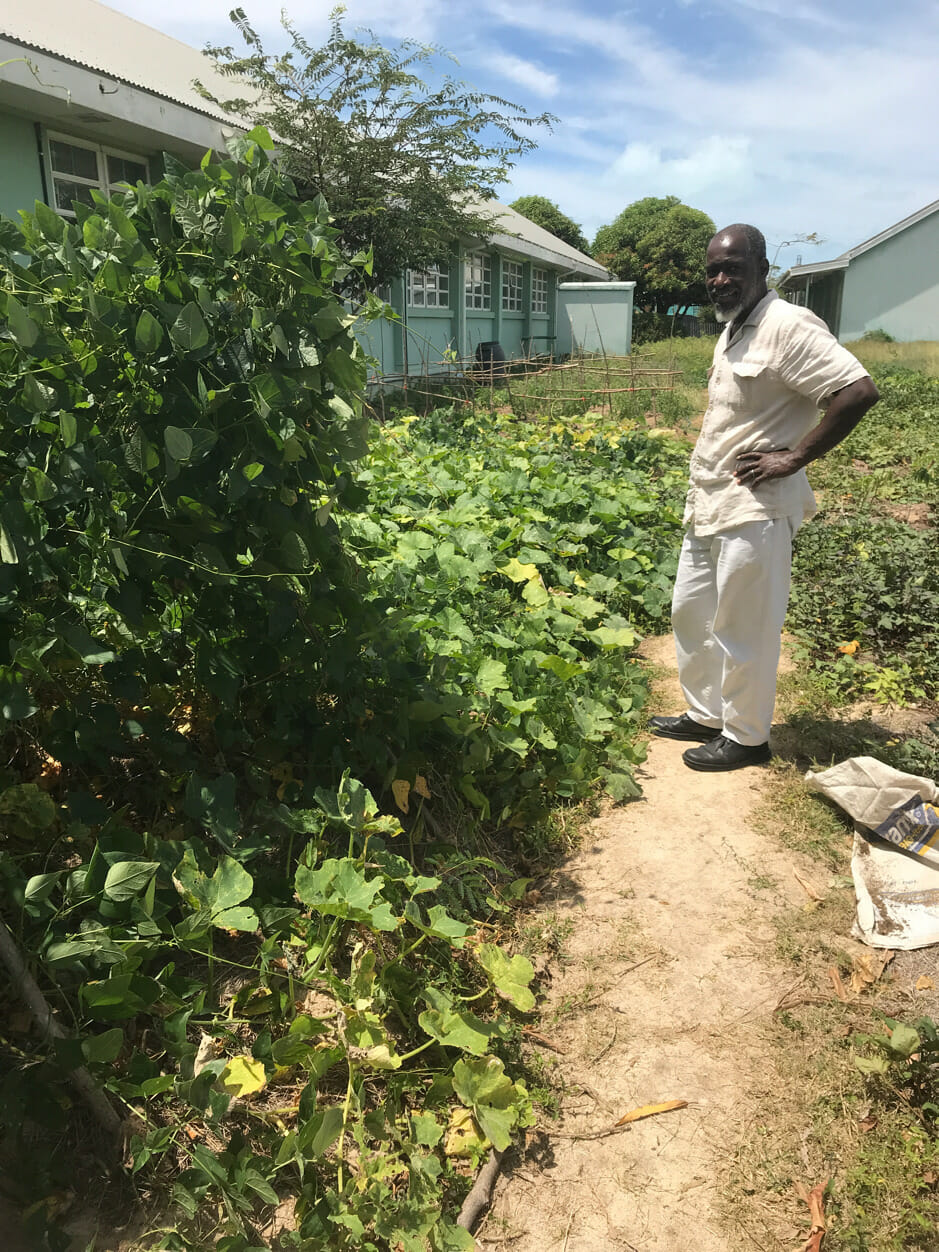
John Mussington, Principal of the Barbuda High School with experimental agricultural plots. The plot on the left had received a small amount of volcanic ash several years before, the control plot on the right received none. The control plot had much lower biomass and production. Photo by Tom Goreau, March 2020
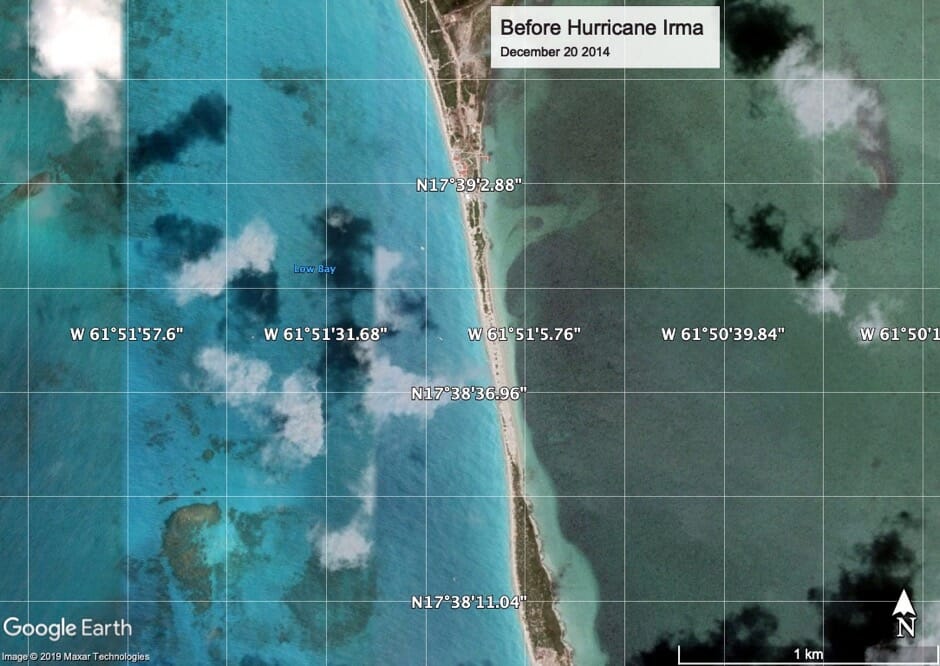
Before Hurricane Irma, a beach separated Codrington Lagoon on the right, the critical nursery for Barbuda’s fish, lobster, and conch, from the Caribbean on the left. The Lagoon has the largest frigate bird nesting colony in the Caribbean
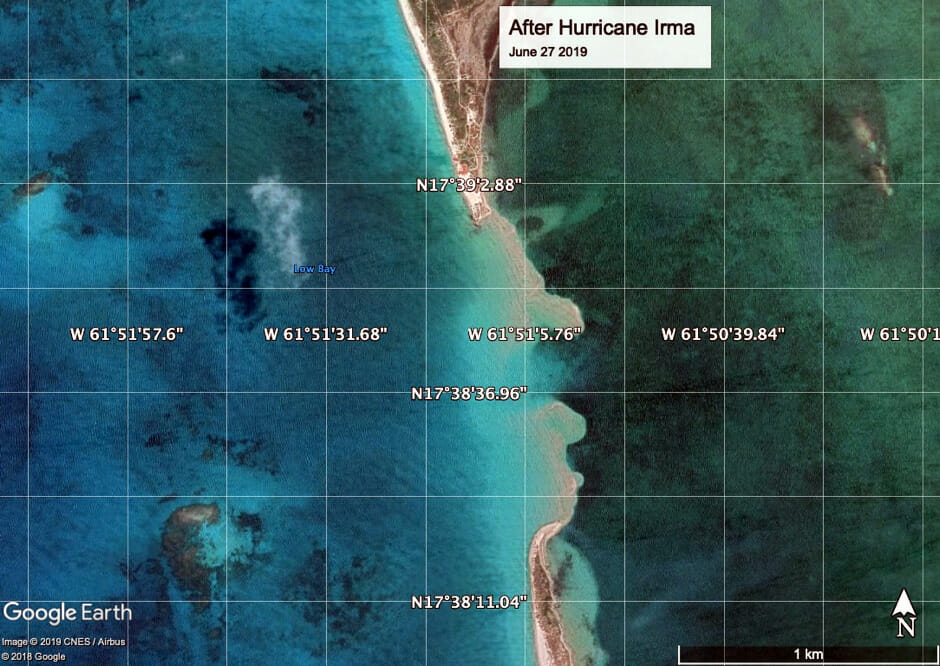
After: Category 5 Hurricane Irma ripped a hole more than a kilometer wide through the beach that has continued to widen, endangering the habitat quality of Codrington Lagoon. The Barbuda Council is seeking funds for a Biorock project to close the gap and GCRA has proposed Biorock mariculture and habitat restoration projects with the Barbuda Fishermen’s Cooperative
Mexico
Covid delayed the start of Biorock fisheries mariculture and sustainable ocean energy and materials projects with the Comca’ac Indigenous People of the Sea of Cortes, Sonora. These projects are discussed in Tom Goreau’s invited keynote presentation to the United Nations 2020 Oceans Day on regenerating fisheries in the Sea of Cortes. Covid also delayed projects with Maya fishermen at Tulum in Quintana Roo, which will focus on regenerating lobster populations.
Biorock projects installed in Cozumel in 2018 were affected by several severe hurricanes during the record-long 2020 hurricane season. Severe deterioration of water quality from sewage pollution in Quintana Roo tourism areas in recent years has caused massive blooms of harmful algae and coral diseases, smothering the corals and killing them. Six Biorock projects built in Cozumel in 2017 had been designed to resemble video game characters, at the request of the sponsor. GCRA warned that three of their designs were inherently unstable in strong waves, and as predicted these three structures were toppled over by 2020 hurricanes. The three structures with stable designs suffered no damage. However, it is likely that they are no longer under power due to hurricane damage to the power cables, which were improperly installed by the local contractor. Qualti Engineering, which received the entire project cash budget for installation, monitoring, maintenance, and repair, and which holds the Mexican Government permits for the site, is responsible for repairs.
Spain
The Global Coral Reef Alliance formed a partnership in January 2020 with Blue Regeneration SL, a Spanish company for greatly improving GCRA’s Biorock Technology for powering large-scale regeneration of coastal ecosystems and severely eroding beaches worldwide with more efficient smart control systems. GCRA’S President Tom Goreau is Chief Scientist of BR, and Thomas Sarkisian, GCRA Vice President, is BR’s Chief Technology Officer. This allows the development of large commercial Biorock projects by BR, while GCRA will continue to focus on projects with non-profit groups, especially locally managed groups in developing countries and indigenous communities that have designated environmental management responsibility. Improved technology developed by BR will be available to groups working with GCRA. Permission has been received by the Spanish Government to regenerate severely eroded beaches, and many projects are in development with groups all over the world. Half the world’s beaches are expected to vanish by the end of this century, and Biorock is the only method that regrows severely eroded beaches at record rates by regenerating the coastal ecosystems that protect them from waves while regenerating coastal fisheries.
Jamaica
A captive dolphin operation opened in 2019 at Puerto Seco Beach, Discovery Bay, over objections of the community and scientists due to water quality concerns, and in violation of national laws banning the discharge of wastes into designated marine protected areas. As predicted by Tom Goreau based on a study of captive marine animal impacts on coral reefs in Mexico and Grand Cayman, it immediately caused water quality deterioration from suspended bacteria and dolphin feces, algae overgrowth of corals and seagrasses, and skin infections. The foul smell quickly caused the closing of Puerto Seco, one of Jamaica’s most popular public beaches for the local population (where TG learned to swim and dive). The captive dolphin facility was suddenly shut down after Covid caused the collapse of cruise ship tourism and the dolphins were removed. Almost immediately the water cleared up, the foul odor went away, the weedy algae smothering corals and sea grasses died away, and people could swim again without getting skin and ear infections.
Next to Discovery Bay, the remarkable ancient sea level caves that show the world’s best record of long-term changes of global sea level and temperature to carbon dioxide over tens of millions of years, which had been designated for national preservation thanks to the work of the late University of the West Indies Professor Thomas Goreau in the 1950s and 1960s, is threatened by a quarry project. The mining is adamantly opposed by local residents, and was rejected by the Jamaican National Environmental Planning Agency on environmental grounds, but their rejection was directly overruled by the Prime Minister.
This unique site allows Jamaicans and the entire world to see the long-term effects of global climate change (see photo below), and where the world is headed if we don’t reverse global warming and sea level rise. Tom Goreau of GCRA wrote the first description of these remarkable fossil climate change records when he was 14 years old and has since studied geological formations of this age all around the world. The Jamaican sites are the best preserved and most complete known in the world, but many of them have been irreparably damaged by officially approved and unofficial quarrying, and some key sites are used to dispose of trash and human feces. The remaining undamaged sites need to be protected and designated a UNESCO World Heritage Site for Global Climate Change. GCRA will soon post a White Paper on the global importance of these sites, and the urgency of Jamaica protecting them. There’s a great video about the biological uniqueness of this area:
Biorock technology for marine ecosystem restoration was invented and developed in Jamaica in the 1980s but has been ignored in its homeland because funding agencies make money available to copy foreign methods but not to implement superior locally-developed technology. Biorock reefs in Negril 25 years ago had more than 100 species of coral reef organisms per square meter but unfortunately were not maintained. Meanwhile, GCRA and its partners have done more than 600 Biorock projects in more than 45 countries around the world, almost all on the opposite side of the world, in the East Indies rather than the West Indies.
Five new Biorock dome reefs were installed in Negril in December 2020 despite extremely hazardous wave conditions due to the record-long hurricane season, unsafe equipment, and dangerous entry and exit conditions. These new projects feature many remarkable Biorock technology advances due to the extremely hard work and ingenuity of GCRA’s VP Thomas Sarkisian. They are the most energy-efficient Biorock projects yet installed, and the most hurricane-proof. The projects rescued hurricane-damaged coral fragments that would have died and is propagating them. Since there are so few corals now left, we are starting from a very small base.
Within a few days, several millimeters of new coral growth was seen, corals cemented themselves to the structure with new growth, new branch formation was starting on endangered elkhorn and staghorn coral fragments, coral fragments that had been bleached white by falling into sand regained their color as their microscopic internal symbiotic algae proliferated, coral polyps expanded their tentacles to feed, physically damaged coral tissue healed, and many fish moved in. A Jamaican diver, Sharren Robinson, will document the project, and we are seeking funds for a scholarship for him to monitor the project for a Marine Science MSc degree at the University of the West Indies.
GCRA continues to work with Jamaican fishing communities to regenerate coral reefs and fisheries habitat, maintaining a 70 year old tradition. The late Professor Thomas F. Goreau helped Jamaican fishermen legally designate all the fishing beaches on the island so that they would not become captured by hotels and closed to locals by becoming what Jamaicans call “white people’s beaches”. GCRA met with the Negril Environmental Protection Trust and the Negril Coral Reef Preservation Society leaders, Keisha Stewart and Jean Brown, to plan the formal implementation of Fish Sanctuaries, managed by local fishermen, in an area of critical biodiversity and fish nursery habitat importance, one of the last remaining in Jamaica. This site had been specifically designated in the original management plan 25 years ago, but never implemented. GCRA will post Sharren Robinson’s video of the reef and an interview with Ceylon Clayton of the local Fishermen’s Cooperative about local protection and mariculture development needs. He describes how Biorock projects there 25 years ago resulted in dense lobster populations.
GCRA President Tom Goreau was the Negril Coral Reef Preservation Society’s first Scientific Advisor, led the founding of the Negril Environmental Protection Trust with the late Katy Thacker and Jean Brown, and developed its Whole Watershed and Coastal Zone Environmental Management Plan based on integrated nutrient monitoring and management. The NEPT plan founded the “Ridge to Reef” and “Hilltop to Ocean” management concepts since widely applied around the world. GCRA was formed in 1990 to represent NCRPS and other Third World grass-roots bottom-up community-based coral reef protection groups at the United Nations Conference on Sustainable Development (the “Earth Summit”) in Rio de Janeiro in 1992, and to push for funding for coral reef regeneration and cleaning up water quality around the Tropics. These efforts failed due to a lack of interest from rich countries and the international “development” agencies whose funding they control, and the failure of island nation leaders to stand up for the essential need to protect their coral reefs, people, and entire countries against global climate change. Rich countries pressured coral reef countries into signing a climate change treaty that was not just a death sentence but a suicide pact for coral reefs and low islands and coasts. There has been no meaningful change since, coral reef countries worldwide have had their endogenous development capacity suffocated by reliance on outside funding doled out to outsiders, and not to locals, while the death of corals by preventable pollution, disease, and global warming accelerate uncontrolled. There is very little time left to reverse course and save coral reefs and the species and people who depend on them.
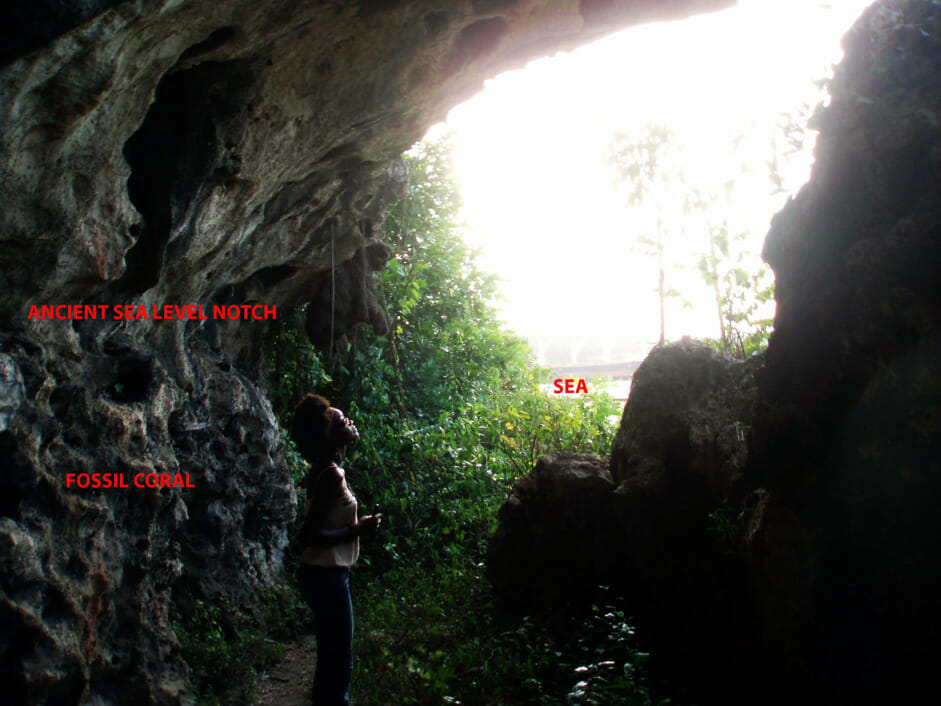
Jamaica has some of the best-preserved record of global climate change preserved in ancient sea level caves formed over millions of years. These have allowed scientists to determine how sensitive global sea level and temperature are to Carbon Dioxide, and how much they will change in the future. These unique formations should be UNESCO World Heritage Sites for Climate Change, instead, they are threatened with destruction from quarrying. Tracey Edwards, a Jamaican marine biologist who has worked with GCRA on projects in Jamaica and in the Grenadines, has her head below where sea level used to be 120,000 years ago, about 7 meters above today’s sea level. Photo by Tom Goreau
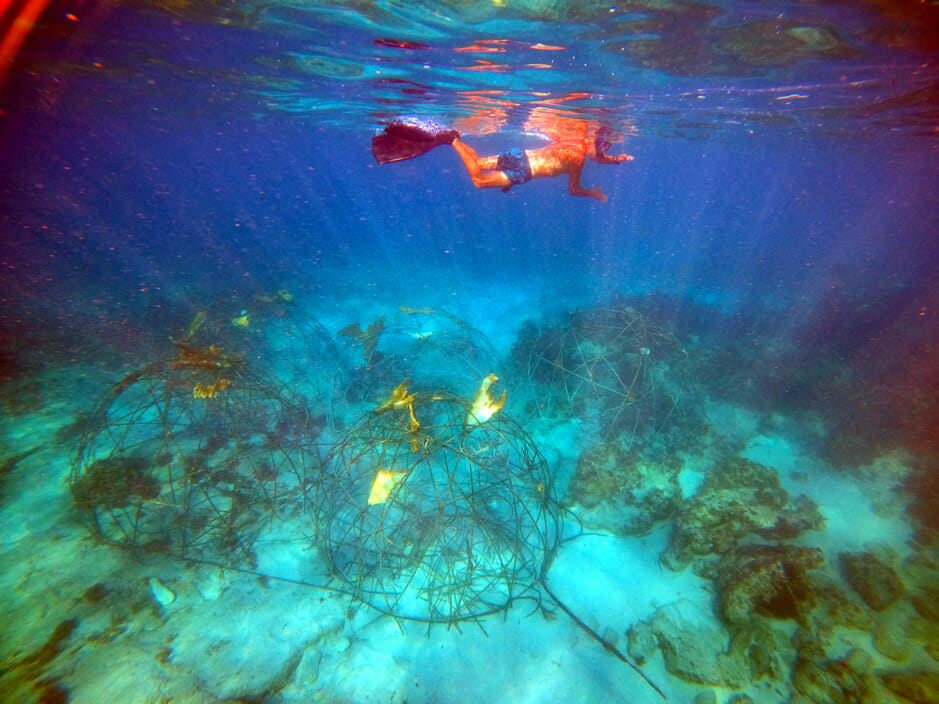
5 New Biorock reefs in Negril. Because there is now so little coral left, we are starting from a very low baseline of rescued corals that were broken by hurricanes in October. Photo by Sharren Robinson, Dec 20 2020
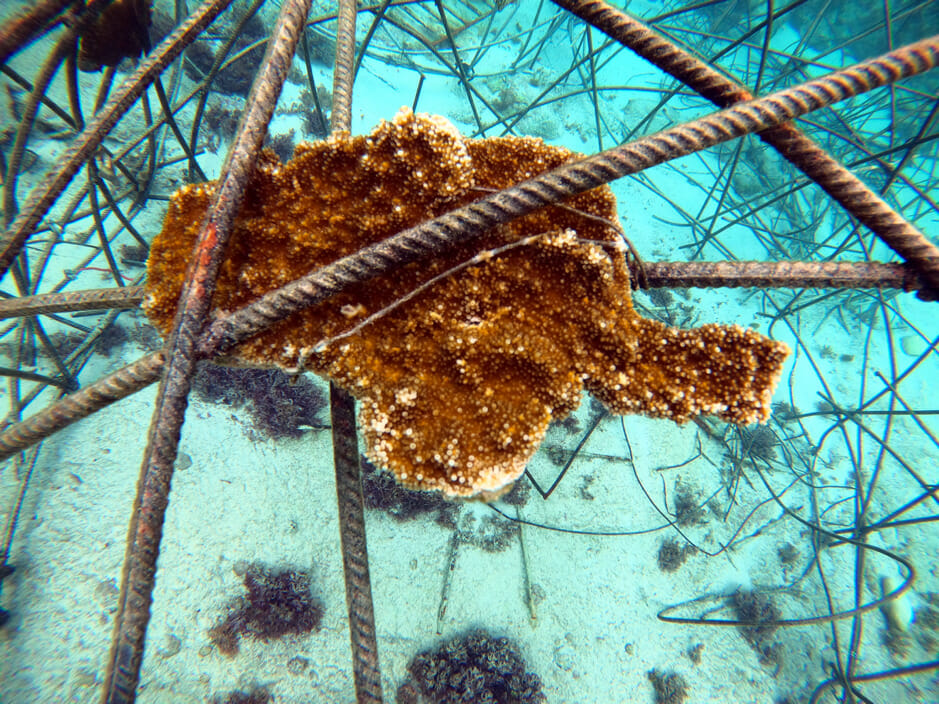
Three days after attachment, this rescued broken elkhorn fragment has already overgrown the wire in several places. It will soon start to form new vertical branches. Photo by Sharren Robinson, Dec 20 2020
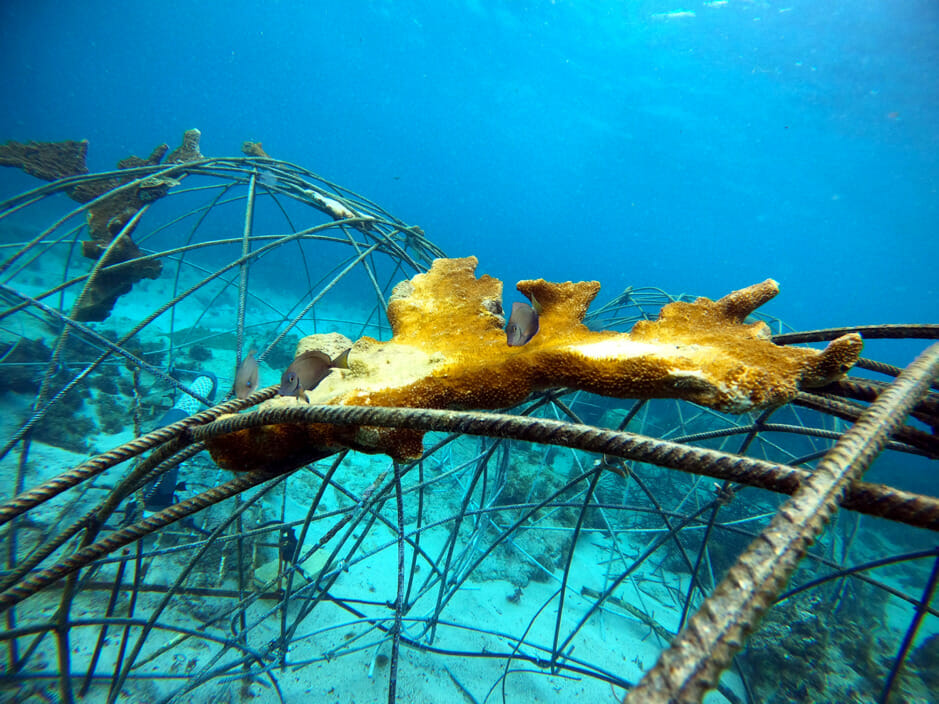
This broken elkhorn fragment was badly bleached because it fell into sand. Within days the bleached areas started to darken as the coral tissue recovered rapidly. Note the three young doctorfish. Many young surgeonfish, parrotfish, wrasses, hamlets, and jacks rapidly moved into the structures, along with a flounder. As the corals grow, many more will come. The site is unprotected, and dozens of spearfishmen may pass by in a day, shooting all the juvenile fish they can catch. Photo by Sharren Robinson, December 20 2020
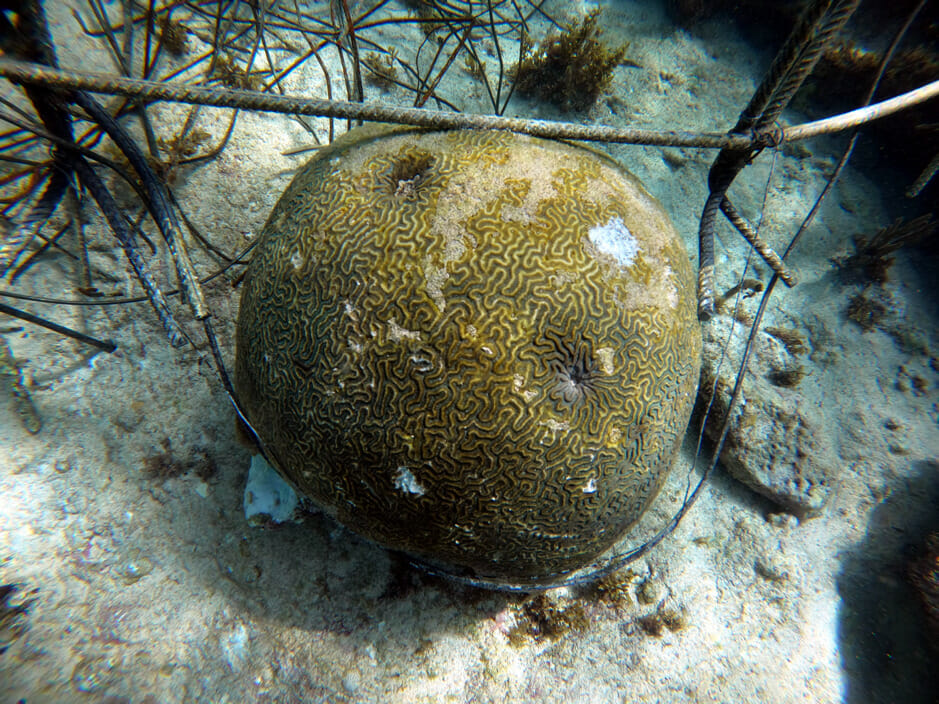
This large brain coral, about a meter across, used to be beacon on top of pedestal of dead coral. A hurricane in October broke it off, because the base had been riddled out by boring sponges and boring sea urchins. The brain coral tissue was severely damaged and scraped by rolling around upside down on rocks and sand in heavy waves for weeks before we could rescue it. Within days of connection to the Biorock structure the pale damaged coral tissue rapidly began to heal and regain its color. Photograph by Thomas Sarkisian, December 19 2020
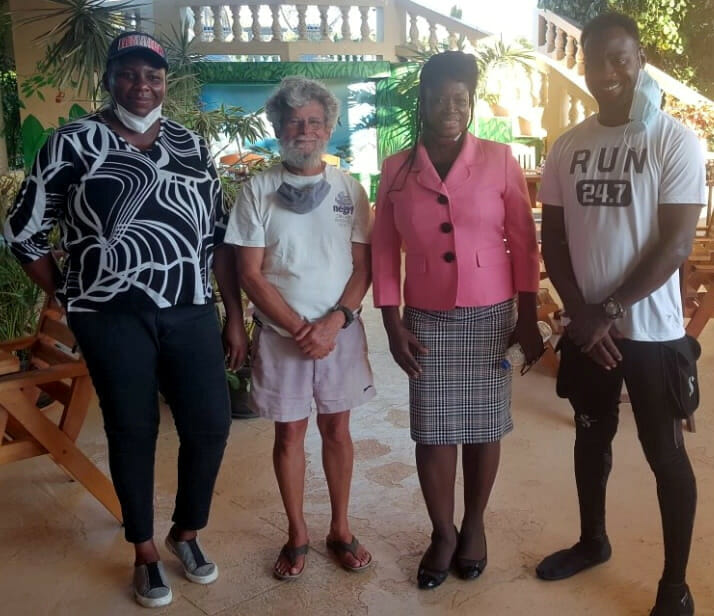
Meeting with the Negril Environmental Protection Trust and the Negril Coral Reef Preservation Society, December 2020. Left to right, Keisha Stewart, Tom Goreau, Jean Brown, Sharren Robinson. TG is wearing the last original NCRPS TShirt from 25 years ago. Photo by Parchy
Coral Ghosts
Coral Ghosts, the first full-length documentary film to cover the long-term global destruction of coral reefs, premiered virtually at the Planet In Focus Environmental Film Festival in Toronto and will be broadcast on the Canadian Broadcasting Corporation in early 2021. Information on when the film will be viewable will be posted soon. The film will become available in 2021 for benefit showings to support local Biorock Ark coral reef regeneration projects in developing countries to save coral reefs for future generations.
